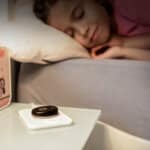Build Your Child’s Communication Skills With This Fun Halloween Game
Lots of kids love Halloween, so use that enthusiasm to get them excited about learning, too. With fun, holiday-themed activities, they won’t even realize they’re training their ears.

Here is a spooky Halloween-themed game to help your child improve their listening and communication skills.
How to Play Bug Bingo With Younger Children
- Print the pictures on lightweight card stock. Cut out the bug cards and the game boards with your child, talking about and describing the bugs as you do so.
- Ask your child to hand out one game board to each player.
- Place the bug cards face down in a pile.
- Take turns taking a bug card–without showing the picture–and talk about what it is. For example, ”This is a bug that is very slow. It’s a snail.” Or, “This is an insect with eight legs. It’s a spider.”
- Everybody with that bug puts a token (you can use coins, paperclips, etc. as tokens) on top of the picture on their game board.
- The first person to cover three pictures in a row wins the game and shouts, “Bingo.”
While playing the game with your child:
- Use Acoustic Highlighting on key words, such as the names of the insects or describing words, to help your child understand your descriptions. Put key words at the end of your sentences to make it easier for your child to listen to and remember the insect they have to find. For example, ”This one is a caterpillar.”
- Hide the picture on the card to encourage your child to listen to your words before focusing on the picture. If your child can easily find the bug, you can make the task more difficult by shifting the key word to the middle of the sentence. Ask, for example, ”Who has a bee on their card?” If they can’t find the bug, repeat the name of the insect again at the end of the sentence: “Who has a bee?”
- Add more information while looking at each bug so your child begins to build associations between words and learns new describing and action words. For example, ”This bug can fly. It emerges from a cocoon. It’s a butterfly.” Or, “This card shows an insect that makes a web to catch its food. It’s a spider.”
- Use extension and expansion by adding another piece of information to your child’s comments. This will model more complex language and concepts for them to learn. If your child only says the name of the bug when it’s their turn, model a complete phrase back to them like, ”Oh, you have the green caterpillar on your card.”
How to Play Bug Bingo With Older Children
This game can also be fun for children who aren’t as young. Use the following tips to make the game a bit more challenging and help older children learn even more.
- While you’re cutting out the bugs, point out the ones that are similar, for example the green grasshopper and the brown grasshopper. Talk about what the bugs eat, where they live, or how they move.
- Make the tasks more difficult by using descriptions instead of the names of the bugs. For example, “Who has an insect that is brown and has six legs? It can jump very high and has antennae.” If they can’t find it, say the name of the insect: “Who has a brown grasshopper?” And then repeat the description.
- Model appropriate phrases for your child to use with their peers when they win a game. For example, “I was lucky this time, but you might win the next game!” Or when you lose a game, offer a handshake and say, “Good game.”
Looking for more fun rehab activities? The Murat Reader Series and the MED-EL Lesson Kits are great resources to support your child’s listening skills at home. Download them now for free!
Thanks for your message. We will reply as soon as possible.
Send us a message
Field is required
John Doe
Field is required
name@mail.com
Field is required
What do you think?
© MED-EL Medical Electronics. All rights reserved. The content on this website is for general informational purposes only and should not be taken as medical advice. Contact your doctor or hearing specialist to learn what type of hearing solution suits your specific needs. Not all products, features, or indications are approved in all countries.



